2017 Mazda3 Vs Honda Civic Hatchback

There’s little doubt that the small car segment is a shrinking one, though the situation may not be as dire as it seems on the surface.
It’s still responsible for a huge percentage of new car sales in North America each year, proving that not everyone is crazy for crossovers. Sure, it’s given up ground to small CUVs in recent years, a trend that’s likely to continue, but this is a segment still rife with competition. And that’s especially true of the small hatchback subsegment, which has seen a newfound resurgence as of late.
Existing entries like the Mazda3 have been joined by the likes of the five-door Honda Civic as brands look to carve out their respective niches in a segment that caters to many needs. For some it’s all about affordable fun, while for others it’s predicated on practicality. Regardless, there are plenty of reasons to get excited about what this segment has to offer, starting with those aforementioned entries.
Both are new for 2017 — the Civic hatch being all-new, and the Mazda3 receiving a well-deserved refresh — and ready to vie for your hard-earned dollars, bringing with them merits that are each their own. But there can only be one winner in the AutoGuide.com arena, so we put both through their paces in an old-fashioned small-car shootout to see which one reigns supreme.
Get the Flash Player to see this player.
A Journey Through Design and Space
The newfound resurgence of the compact hatchback segment has seen automakers like Honda get back in the game after years of neglect. When it comes to the Civic, it’s been about 15 years since it was sold in hatchback form in North America, and even longer since a five-door version like this new one was available. (For the last time such a Civic was sold in this part of the world, you’d have to look back to the late 1980s and the so-called Civic Wagon.)
Honda’s taken some flack about the Civic’s design since this new one was introduced back in 2015, but the brand deserves credit for making its compact car stand out. So many cars look the same nowadays, but the new Civic is refreshing at the very least — something that continues with this hatchback version.
Everything from B-pillar back has been replaced compared to Civic sedan, with the car measuring more than four inches (102 millimeters) shorter overall. Despite that lost length, the Civic hatch is still sizeable, measuring 177.9 inches (4,519 mm) from bumper to bumper. It also boasts a decent amount of room inside, with a similar amount of passenger space to the Civic sedan and a ton more cargo volume.
Compare Specs
| Vehicle | 2017 Mazda3 5-Door | Advantage | 2017 Honda Civic Hatchback |
|---|---|---|---|
| Engine | 2.5L 4-cylinder | - | 1.5L turbo 4-cylinder |
| Horsepower | 184 hp | Mazda3 | 174 hp |
| Torque | 185 lb-ft | Mazda3 | 162 lb-ft |
| Transmission | 6-speed manual/auto. | Mazda3 | 6-speed manual; CVT |
| Cargo Capacity (cu-ft) | 20.2; 47.1 | Civic | 25.7; 46.2 |
| Cargo Capacity (liters) | 572; 1,334 | Civic | 728; 1,308 |
| US Fuel Economy | 30 mpg combined | Civic | 34 mpg combined |
| CAN Fuel Economy | 7.9 L/100 km combined | Civic | 6.9 L/100 km combined |
| US Price | Starts at $20,145 | Civic | Starts at $19,700 |
| CAN Price | Starts at $19,550 | Mazda3 | Starts at $21,490 |
With 25.7 cu-ft (728 liters) of space behind the back seats, the Civic offers way more cargo room than pretty much everything in the segment, including the Mazda3. Folding the second row opens up 46.2 cu-ft (1,308 liters) of space for stuff, which is plenty. The Honda Civic hatchback also has a handy privacy cover that extends out from either side of the cargo area for easy, one-handed operation. But best of all, the entire assembly is only a little larger than a brick, which means it’s out of the way until needed and won’t be forgotten in the garage.
The 2017 Mazda3, meanwhile, has undergone a far more subtle overhaul. In fact, park this 2017 version next to its pre-facelifted predecessor and only the most acutely aware would be able to spot the differences. Compared to the Civic, the Mazda3 is clearly the safer stylistic bet, though it’s certainly far from unattractive. It retains the same flowing lines as before, with only a few minor tweaks to the front and rear fascias and some new wheel designs rounding out the unassuming exterior changes.
Much like the Civic, the hatchback version of the Mazda3 is shorter than the sedan — in this case, about five inches (127 mm) shorter. At 175 inches (4,445 mm) from tip to tail, the Mazda is among the smallest entries in the segment, and comes in at roughly three inches (76 mm) shorter than the Civic hatch. And while that may seem inconsequential, it puts the Mazda at a clear disadvantage, particularly behind the tailgate.
Room behind the rear seats stands at a paltry 20.2 cu-ft (572 liters), which is near the bottom of the small hatch pack. While still offering more than enough room for everyday errands, weekends away may pose a bit of a problem. The Mazda does, however, strike back with the rear seats folded, with its 47.1 cu-ft (1,334 liters) actually putting it near top of segment, and even slightly better than the Civic. It’s a similar story when it comes to passenger room, with the Mazda3 surrendering some space to the segment’s leaders, though not as much as one might suspect.
Opposing Power Sources
When it comes to their powertrains, the Mazda3 and Civic hatch take divergent paths that reflect their age. As a new kid on the block, the Civic is only available with a turbocharged engine, in this case a 1.5-liter four-cylinder. Output varies depending on transmission, but power is plentiful whether it’s going to the front wheels through manual or automatic transmissions.
The engine churns out 174 horsepower to go with 162 lb-ft of torque in cars equipped with the continuously variable transmission or 167 lb-ft of torque with the six-speed manual. Sport models, meanwhile, get a slight bump in output to 180 horsepower and 177 lb-ft of torque (the same 162 lb-ft is on tap with the CVT). The engine’s full serving of torque kicks in at about 1,800 rpm, providing a decent punch without much room for turbo lag.
When it comes to the Civic’s transmissions, neither are anywhere near the best in the segment. Our tester was fitted with the six-speed manual, which features a feather-light shifter and vague clutch, while the continuously variable automatic has a fair amount of the rubber-banding effect that makes it seem like power’s coming from a pissed-off sewing machine.
ALSO SEE: 2017 Honda Civic Sport Hatchback Review
While the Civic has been caught up in the turbocharging trend, the Mazda3 sticks with natural aspiration to make power. The compact gets the choice of either 2.0- or 2.5-liter engines under hood, both of which offer pretty good output. The smaller of the two four-cylinders makes 155 horsepower and 150 lb-ft of torque, while the the 2.5-liter makes 184 horsepower to go along with 185 lb-ft of torque.
Either engine can be mated to the choice of manual or automatic transmissions, both of which feature six forward gears. Both transmissions are better than the ones offered in the Civic, with far more natural feel — especially in the automatic. Like the one in the Civic, the Mazda’s clutch is soft and light, though it’s surprisingly compliant.
No matter which engine-transmission combo the Mazda3 features, its fuel economy isn’t as good as the Civic’s. With the 2.0-liter under the hood, the Mazda gets the same 31 mpg (7.5 L/100 km) combined regardless of gearbox, while the larger engine combined with the manual does slightly worse at 28 mpg (8.3 L/100 km) and 30 mpg (7.9 L/100 km) with the automatic. The Civic, meanwhile, with its much more modern powertrain, gets fuel economy ratings of 33 mpg (7.2 L/100 km) combined with the manual transmission and 34 mpg (6.9 L/100 km) with the CVT. Our actual fuel economy with both cars was closer to their respective city averages during our testing, though conditions were less than optimal and both were clad in winter tires.
A Better Drive
When it comes to the way the two competitors drive, the Mazda3 comes out on top — especially when it comes to sheer engagement. As part of its update for 2017, Mazda revised the compact’s suspension setup to include new dampers at all four corners. While not exactly wholly different than before, they do a nice job of providing a smooth and quiet ride that errs on the sporty side. The same goes for the tight chassis and nicely weighted steering setup, which both make the Mazda fun to drive when called upon.
The Mazda3 also features a new G-Vectoring Control system that uses engine braking to improve cornering performance. Unlike other automakers’ brake-based systems, Mazda’s G-Vectoring reduces engine torque ever so slightly in response to steering input, shifting more of the car’s weight to the front wheels for improved traction and turn-in response. As the car works through the turn the torque that was put on hold is reengaged, shifting the weight back to the rear wheels for improved stability and corner exit. The whole process happens in a split second and is virtually imperceptible while behind the wheel, but that’s the point.
ALSO SEE: 2017 Mazda3 2.5L Review
The Civic, however, is no slouch either and can be fun to drive while also smoothing uneven roads with ease. Like the Mazda3, the Civic features front MacPherson struts and a multi-link rear suspension. The Civic’s steering, however, isn’t quite as dialed in as the Mazda’s and it doesn’t provide as much feedback, though the brake-based torque-vectoring system works well to improve the car’s cornering ability even if there’s slightly more body roll.
On its own the Civic hatch seems like a fun car to drive, but compared to the Mazda3 it’s sort of sloppy. And that’s why it’s crucial to test drive at least a couple of cars when shopping for a new one. Even for those folks dead-set on a certain model, driving another one or two competitors before buying can help reinforce strengths and, more importantly, identify weaknesses.
Superior Interior
Inside, both the Mazda3 and Honda Civic have good things going for them. While styling is subjective, the Mazda’s cabin features a design that’s a little easier on the eyes thanks to cleaner, more symmetrical lines and a greater array of materials. That story is certainly true in higher trim grades, with the leather in the Mazda feeling more supple and substantial than the stuff used in the Honda.
There’s nothing inherently wrong with the Civic’s cabin, though certain materials aren’t all that nice to the touch — especially on lower grade trims. It is, however, a pretty good package for the price. The Civic hatch starts at $19,700 ($21,490 in Canada), which is slightly more than the Mazda3 hatch though still pretty budget-friendly. That base price doesn’t include a whole lot of desirable features, though they can be added for nominal price increases.
Items like a seven-inch touchscreen infotainment system with Apple CarPlay and Android Auto capability, for example, comes into play on the Sport grade, which commands only a $1,600 premium over base versions. (Canadian cars, meanwhile, feature that same touch-sensitive screen as standard fare.)
ALSO SEE: 2017 Honda CR-V vs Ford Escape
From there, a whole array of comfort, convenience and — and maybe more importantly — safety features can be added, including heated seats and steering wheel, as well as adaptive cruise control, lane-keep assist and forward collision mitigation braking, among others. Those safety features, which make up the Honda Sensing suite, don’t simply cater to demand, but work as well as those offered in much pricier rides.
Shifting to the Mazda’s interior, it’s a similar story to the Honda’s in terms of feature availability, though it still does without those aforementioned smartphone syncing interfaces. The infotainment system, which runs through a seven-inch unit, sits atop the dash and can be operated through the touch of a finger or the console-mounted controller. The interface itself isn’t quite as modern and fluid as Honda’s and looks slightly more juvenile, though it’s easy to adjust to over time.
Like the Civic, the Mazda3 is available with a full suite of safety features, including adaptive cruise control, lane-keep assist, and forward collision mitigation, all of which work well and offer good value for the money. The safety suite can only be added to the top Grand Touring trim, which command a $4,800 premium over the $20,145 base price ($19,550 in Canada). That price is quite a bit less than the Civic’s peak price of $28,300 ($29,490 in Canada) while offering a better overall atmosphere inside.
The Verdict: 2017 Mazda3 vs Honda Civic Hatchback
There’s a reason the Honda Civic and Mazda3 have proven themselves to be two of our favorite five-doors on the market. Both are practical and fun, but neither will break the bank, with the Mazda doing a slightly better job of saving a few bucks. If it weren’t for the crucially important factors of interior space and infotainment, the Mazda3 would have swept this comparison hands down. The Honda bests it in both of those categories, but it’s just not quite as nice to drive, and that’s what it all boils down to in my books when it comes to commuter-friendly compacts.
The new kid on the block gave the savvy veteran a run for its money in this compact shootout, and while the Mazda3 is beginning to show signs of age, it still has what it takes to hold down the top spot on our list of compact hatchbacks on the market.

Dan is AutoGuide.com's Road Test Editor, a long-suffering Buffalo Bills fan, and a car guy since childhood. He enjoys long walks on the beach and long drives just about anywhere the road, track or trail will take him. You'll see him driving around evaluating cars and in front of a camera talking about them. Dan is a member of the World Car of the Year jury.
More by Dan Ilika




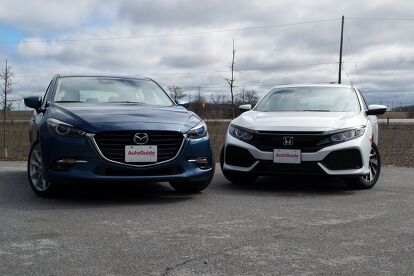





























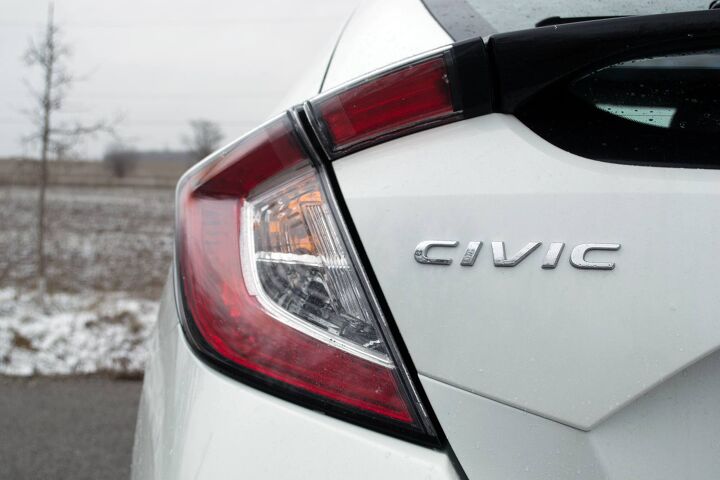


















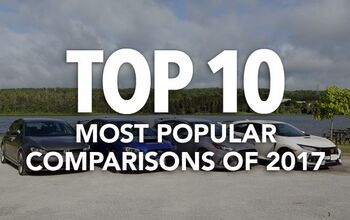

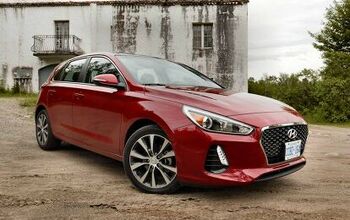

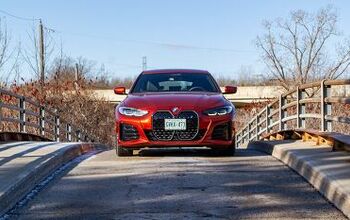


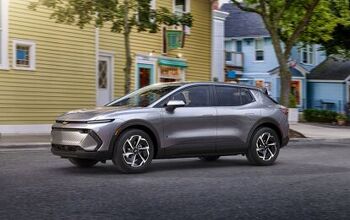

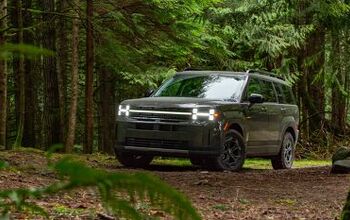
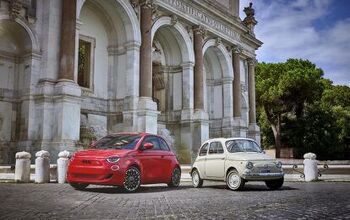
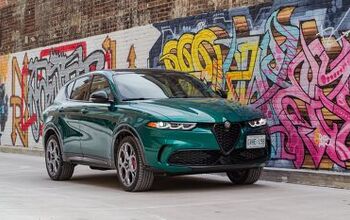
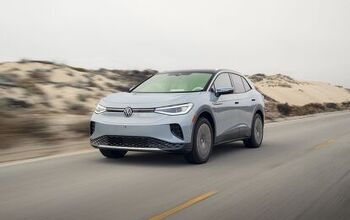
Comments
Join the conversation
Should have tested the Civic Hatchback Sport.
Canadian-Spec Civic Sport Touring with 6-speed Manual transmission! Mike drop. (Mazdas are too prone to corrosion here in Canada - Trust me!)